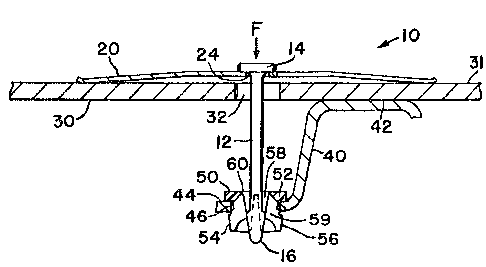Some of the information on this Web page has been provided by external sources. The Government of Canada is not responsible for the accuracy, reliability or currency of the information supplied by external sources. Users wishing to rely upon this information should consult directly with the source of the information. Content provided by external sources is not subject to official languages, privacy and accessibility requirements.
Any discrepancies in the text and image of the Claims and Abstract are due to differing posting times. Text of the Claims and Abstract are posted:
| (12) Patent: | (11) CA 1301081 |
|---|---|
| (21) Application Number: | 1301081 |
| (54) English Title: | RETAINER ASSEMBLY |
| (54) French Title: | DISPOSITIF D'ARRET |
| Status: | Expired and beyond the Period of Reversal |
| (51) International Patent Classification (IPC): |
|
|---|---|
| (72) Inventors : |
|
| (73) Owners : |
|
| (71) Applicants : |
|
| (74) Agent: | MACRAE & CO. |
| (74) Associate agent: | |
| (45) Issued: | 1992-05-19 |
| (22) Filed Date: | 1988-04-22 |
| Availability of licence: | N/A |
| Dedicated to the Public: | N/A |
| (25) Language of filing: | English |
| Patent Cooperation Treaty (PCT): | No |
|---|
| (30) Application Priority Data: | ||||||
|---|---|---|---|---|---|---|
|
RETAINER ASSEMBLY
ABSTRACT OF THE DISCLOSURE
The retainer assembly (10) comprises a longi-
tudinally extending retainer body (12) having an enlarged
diameter or head member (14) at one end and an arrow-
shaped or flared member (16) at the other end. A V-shaped
leaf spring (20) has an opening (24) at the bottom of the
V-shaped opening (22) which receives the retainer body
(12) so that the spring (20) is disposed between the head
member (14) and a surface (31) of a first member (30). The
retainer body (12) extends through an opening (32) in the
first member (30) and the flared member (16) is resili-
ently captured within a resilient receiving member (50)
disposed within an opening (46) of the second member (40).
The opening (46) in the second member (40) is in a second
surface (44) disposed apart from a first surface (42) of
the second member (40) which engages the first member
(30). The receiving member (50) flexibly traps the flared
member (16) after insertion therethrough so that the leaf
spring (20) biases the first member (30) into engagement
with the second member (40).
Note: Claims are shown in the official language in which they were submitted.
Note: Descriptions are shown in the official language in which they were submitted.

2024-08-01:As part of the Next Generation Patents (NGP) transition, the Canadian Patents Database (CPD) now contains a more detailed Event History, which replicates the Event Log of our new back-office solution.
Please note that "Inactive:" events refers to events no longer in use in our new back-office solution.
For a clearer understanding of the status of the application/patent presented on this page, the site Disclaimer , as well as the definitions for Patent , Event History , Maintenance Fee and Payment History should be consulted.
| Description | Date |
|---|---|
| Inactive: IPC from MCD | 2006-03-11 |
| Time Limit for Reversal Expired | 1997-05-20 |
| Letter Sent | 1996-05-20 |
| Grant by Issuance | 1992-05-19 |
There is no abandonment history.
Note: Records showing the ownership history in alphabetical order.
| Current Owners on Record |
|---|
| ALLIED-SIGNAL INC. |
| Past Owners on Record |
|---|
| DONALD DIXON JOHANNESEN |
| ROBERT BRUCE TEMPLE |